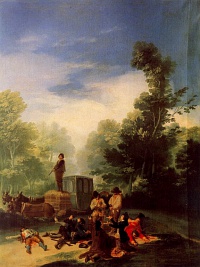True crime
From The Art and Popular Culture Encyclopedia

|
"She remembered that on her husband’s left shoulder, almost on the neck, there used to be one of those small, almost imperceptible, but ineffaceable birthmarks. Martin wore his hair very long, it was difficult to see if the mark were there or not. One night, while he slept, Bertrande cut away a lock of hair from the place where this sign ought to be—it was not there!" --Martin Guerre, from Celebrated Crimes (1839-41) by Alexandre Dumas "Accounts of true crime have always been enormously popular among readers. The subgenre would seem to appeal to the highly educated as well as the barely educated, to women and men equally. The most famous chronicler of true crime trials in English history is the amateur criminologist William Roughead, a Scots lawyer who between 1889 and 1949 attended every murder trial of significance held in the High Court of Justiciary in Edinburgh, and wrote of them in essays published first in such journals as The Juridical Review and subsequently collected in best-selling books with such titles as Malice Domestic, The Evil That Men Do, What Is Your Verdict?, In Queer Street, Rogues Walk Here, Knave's Looking Glass, Mainly Murder, Murder and More Murder, Nothing But Murder, and many more…. Roughead's influence was enormous, and since his time "true crime" has become a crowded, flourishing field, though few writers of distinction have been drawn to it."--Joyce Carol Oates, The New York Review of Books, 24 Jun 1999 |
|
Related e |
|
Featured: |
True crime is a non-fiction genre in which the author uses an actual crime and real people as a point of departure. They can be fairly factual or highly speculative and heavily fictionalized depending on the writer. Some works are "instant books" produced quickly to capitalize on popular demand while others may reflect years of thoughtful research and inquiry. Still others revisit historic crimes (or alleged crimes) and propose solutions, such as books examining political assassinations, well-known unsolved murders, or deaths of celebrities.
Contents |
17th century
Purportedly factual accounts of actual crimes have a long history. In the 17th century, criminal biography was already an existing genre. These works were popular then, as now, because they could offer a touching account of need, a fall from innocence, sex, violence, and then repentance or a tearful end. Public fascination with the dark side of human nature, and with the causes of evil, has never waned, and the market for mass produced accounts was large.
When Jonathan Wild was hanged, the papers were filled with accounts of his life, collections of his sayings, farewell speeches, and the like. Daniel Defoe wrote one narrative for Applebee's Journal in May and then had published True and Genuine Account of the Life and Actions of the Late Jonathan Wild in June 1725.
By 1701 there had been a Lives of the Gamesters (often appended to Charles Cotton's The Compleat Gamester), about notorious gamblers. In 1714 Captain Alexander Smith had written the best-selling Complete Lives of the Most Notorious Highwaymen. Defoe himself was no stranger to this market: his Moll Flanders was published in 1722. Further, he had, by 1725, written both a History and a Narrative of the life of Jack Sheppard. Moll Flanders may be based on the life of one Moll King, who lived with Mary Mollineaux/Milliner, Wild's first mistress.
19th century
20th century
The works of author Yseult Bridges about British cases; Inspector Dew's I Caught Crippen (1938); and the Notable British Trials series were all works that can be regarded as true crime. Jack Webb's 1958 The Badge (recently republished with an introduction by James Ellroy) embodies elements of the modern true crime story, but Truman Capote's In Cold Blood is usually credited with establishing the modern novelistic style of the genre.
Many works in this genre explore (and sometimes exploit) high-profile, sensational crimes such as the JonBenét Ramsey killing, the O.J. Simpson case, and the Pamela Smart murder, while others are devoted to more obscure slayings. Prominent true crime accounts include Helter Skelter by lead Manson family prosecutor Vincent Bugliosi and Curt Gentry; Ann Rule's The Stranger Beside Me, about Ted Bundy, and Joe McGinniss' Fatal Vision.
The modern genre, which most often focuses on murders, is frequently marked by biographical treatment of the criminals and victims, attempts to explain criminal psychology, and descriptions of police investigations and trial procedures.
Although true crime books often center on sensational, shocking, or strange events, a secondary part of their appeal is social realism that describes events too mundane, risqué or deviant for other non-fiction media, including descriptions of the lifestyles of working-class or socially marginal people.
After the success of the movie The Silence of the Lambs, a subgenre of true crime has focused on methods of "profiling" of unidentified criminals, especially serial killers.
See also

